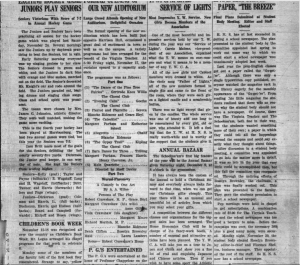For our presentation we are focusing on important figures in JMU, especially the lesser known people. Our goal is to bring attention to these people who helped create the college we know today but that may not be as actively recognized for their contributions. We plan on dividing up important people we found and each doing research on a few of them to combine onto the website. I looked into the creation of the Breeze and I found the first Breeze newspaper edition that was made in the special collections library. The article mentions the creation of the newspaper and the chairman who fought for it as well as some of the reasons for creating a newspaper.
Roselyn Brownley helped to create the Breeze Newspaper and then became the editor in chief after its foundation. The first paper dated at December 2, 1922 talks about why the paper came to life. There were apparently other faculty controlled or academic project newspapers before the foundation of the Breeze but the students felt that they weren’t representative. In response Roselyn Brownley started a committee to try and convince the student body to create a newspaper run by the students about campus life. It took time for her to get enough support from the right people to create the newspaper but eventually she got it up and running. The newspaper initially sold to students for 10 cents per copy.
It is fair to say that Roselyn Brownley somewhat unintentionally created an important primary source for anyone studying the history of JMU. A school newspaper creates a locally focused source of information for the students and a goldmine of documentation for historians. The collections of Breeze articles in the library show important events to the students throughout the decades, ranging anywhere from changes in campus life to popular music. She created a time capsule that lets us go back and view JMU from any point in time that we still have the newspaper for and look at it through a students eyes in that generation. The newspapers in Special collections are now largely digitized and easily accessible to people researching any topic in JMU history and the history of Harrisonburg, as several restaurants and houses in the Harrisonburg area have shown up in the paper. Whatever students deemed important became part of the Breeze and that gives us inside perspective into the minds of the students. The events documented in the breeze became evidence of the history of JMU and can be used to show how we became what we are today. Without the newspaper we would struggle to find documentation on certain social subjects that the school might not have valued
The Breeze, December 2, 1922. Harrisonburg (Va.): State Normal School for Women at Harrisonburg.
https://commons.lib.jmu.edu/i19221929/208/
.


Recent Comments